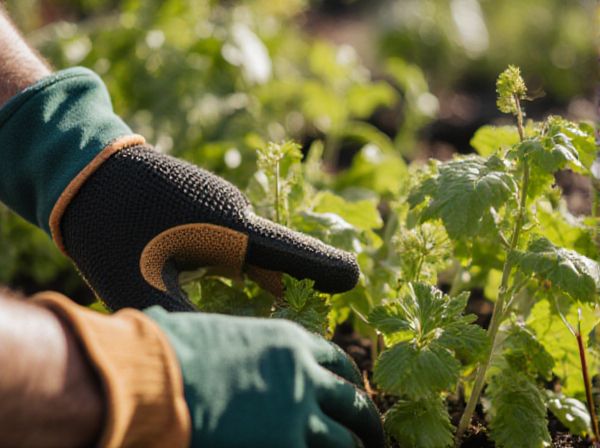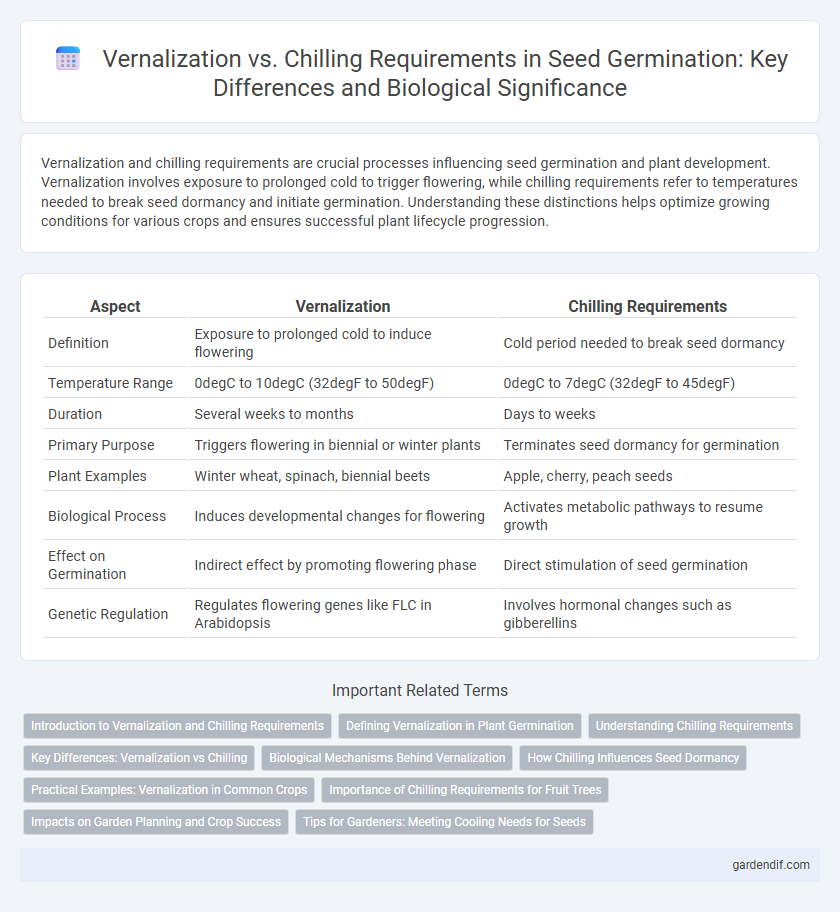
Vernalization vs Chilling requirements Illustration
Vernalization and chilling requirements are crucial processes influencing seed germination and plant development. Vernalization involves exposure to prolonged cold to trigger flowering, while chilling requirements refer to temperatures needed to break seed dormancy and initiate germination. Understanding these distinctions helps optimize growing conditions for various crops and ensures successful plant lifecycle progression.
Table of Comparison
| Aspect | Vernalization | Chilling Requirements |
|---|---|---|
| Definition | Exposure to prolonged cold to induce flowering | Cold period needed to break seed dormancy |
| Temperature Range | 0degC to 10degC (32degF to 50degF) | 0degC to 7degC (32degF to 45degF) |
| Duration | Several weeks to months | Days to weeks |
| Primary Purpose | Triggers flowering in biennial or winter plants | Terminates seed dormancy for germination |
| Plant Examples | Winter wheat, spinach, biennial beets | Apple, cherry, peach seeds |
| Biological Process | Induces developmental changes for flowering | Activates metabolic pathways to resume growth |
| Effect on Germination | Indirect effect by promoting flowering phase | Direct stimulation of seed germination |
| Genetic Regulation | Regulates flowering genes like FLC in Arabidopsis | Involves hormonal changes such as gibberellins |
Introduction to Vernalization and Chilling Requirements
Vernalization is the exposure of seeds or plants to prolonged cold temperatures to trigger flowering or germination, essential for many temperate crops. Chilling requirements refer to the minimum low-temperature exposure needed to break seed dormancy and promote uniform germination or bud break. Understanding both vernalization and chilling requirements enables optimized cultivation strategies by aligning planting schedules with environmental conditions.
Defining Vernalization in Plant Germination
Vernalization in plant germination refers to the exposure of seeds or young plants to prolonged cold temperatures to trigger flowering and growth processes essential for reproductive success. This biological mechanism differs from chilling requirements, which generally involve shorter cold periods needed to break seed dormancy without necessarily inducing flowering responses. Understanding vernalization is crucial for optimizing crop yield in temperate regions by synchronizing flowering times with favorable environmental conditions.
Understanding Chilling Requirements
Chilling requirements refer to the essential exposure to low temperatures that certain seeds or buds need to break dormancy and initiate germination or growth processes. This cold period enables biochemical changes that promote enzyme activation and hormone balance, specifically reducing abscisic acid levels and increasing gibberellins, critical for seed sprouting. Understanding chilling requirements is vital for optimizing crop scheduling and improving germination rates in temperate climates.
Key Differences: Vernalization vs Chilling
Vernalization and chilling requirements both influence seed germination by exposing seeds to cold temperatures, but vernalization specifically triggers flowering after prolonged cold exposure, while chilling primarily breaks seed dormancy. Vernalization typically involves extended cold periods at moderately low temperatures (2-10degC), crucial for temperate biennials and perennials, whereas chilling requirements often refer to shorter cold durations sufficient to overcome seed coat-imposed dormancy. Understanding these distinctions helps optimize cultivation practices for crops like wheat (vernalization) versus fruit trees (chilling).
Biological Mechanisms Behind Vernalization
Vernalization involves the exposure of seeds or plants to prolonged cold temperatures, triggering epigenetic modifications that suppress flowering repressors such as the FLOWERING LOCUS C (FLC) gene. This process alters histone methylation patterns, enabling the activation of genes essential for floral development once favorable conditions return. Unlike general chilling requirements that mainly prevent dormancy, vernalization specifically reprograms gene expression to synchronize flowering with optimal seasonal timing.
How Chilling Influences Seed Dormancy
Chilling requirements play a crucial role in breaking seed dormancy by triggering physiological changes that enable germination. Exposure to low temperatures during chilling activates enzymes and hormones such as gibberellins, which promote embryo growth and weaken seed coat resistance. Unlike vernalization, which primarily affects flowering in plants, chilling specifically targets seed dormancy mechanisms, ensuring seeds germinate under favorable environmental conditions.
Practical Examples: Vernalization in Common Crops
Vernalization involves exposing seeds or young plants to prolonged cold to initiate flowering, as seen in winter wheat and barley, which require this process to transition from vegetative growth to reproduction. In contrast, chilling requirements in fruit crops like apples and cherries are necessary to break dormancy and ensure uniform bud break in spring without triggering flowering. Understanding these distinct cold exposure needs allows farmers to optimize planting schedules and improve crop yield and quality in temperate climates.
Importance of Chilling Requirements for Fruit Trees
Chilling requirements are critical for fruit trees to break dormancy and initiate uniform flowering and fruit set, directly impacting crop yield and quality. Adequate exposure to low temperatures during winter satisfies these chilling hour needs, ensuring proper bud development and synchronization of growth phases. Failure to meet chilling requirements can result in delayed flowering, poor fruit development, and reduced agricultural productivity.
Impacts on Garden Planning and Crop Success
Vernalization requires prolonged exposure to cold temperatures for flowering initiation, influencing planting schedules and crop selection in seasonal gardens. Chilling requirements, crucial for breaking seed dormancy, impact germination timing and uniformity, affecting crop yields and garden productivity. Understanding these temperature-dependent processes aids in optimizing garden planning for successful cultivation and harvest.
Tips for Gardeners: Meeting Cooling Needs for Seeds
Gardeners should differentiate between vernalization and chilling requirements to ensure successful seed germination, as vernalization involves prolonged cold exposure for flowering induction, while chilling promotes seed dormancy break. Seeds from plants like tulips and spinach need specific temperature ranges, typically between 0degC and 10degC, for optimal chilling duration. Using controlled refrigeration or planting outdoors during cooler months helps meet these cooling needs and enhances uniform seed sprouting.
Vernalization vs Chilling requirements Infographic

 gardendif.com
gardendif.com